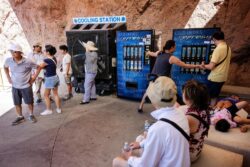KEY POINTS
- 70 million Americans (one in five) are under heat alerts as temperatures expected to rise
- The Northeast and Midwest are bracing for extreme heat, with temperatures potentially reaching 105F
- LA is experiencing wildfires while Montana is experiencing a rare snowstorm with heavy snow expected
- Heatwaves have become more frequent and severe due to climate change
One in five Americans under extreme weather alerts
Around 70 million Americans, or one in five, are under heat alerts as temperatures are expected to soar. The Northeast and Midwest are bracing for extreme heat, with temperatures potentially reaching 105F (41C).
In other parts of the country, a wildfire north of Los Angeles has forced hundreds from their homes. Meanwhile, Montana is experiencing a rare June snowstorm with heavy snow expected.
Scientists attribute these extreme weather events to climate change, which is making them more frequent and intense.
The National Weather Service (NWS) describes this as the first significant heatwave of the season for these regions. The Midwest, Great Lakes, Northeast, and Mid-Atlantic could all be affected until next week.
The NWS warns that some areas will experience dangerous heat levels not seen in decades. This heatwave, caused by a “heat dome” trapping warm air, will expand from the central US to the Northeast and last until Saturday.
Temperatures could reach 105F (41C), and drought conditions may develop in some farming areas. Pittsburgh, Pennsylvania, might set a record high of 97F on June 17. Detroit could see its hottest day in 12 years with a forecast of 96F on Monday. Cities like New York, Philadelphia, and Washington are also expected to hit the high 90s.
Officials advise limiting outdoor activities and staying hydrated, as extreme heat is the deadliest weather condition.
In California, the Post Fire north of Los Angeles has burned about 15,000 acres and is only 2% contained. Hundreds have been evacuated.
Earlier this month, another heatwave broke daily records in the Southwest, including triple-digit temperatures in Phoenix.
While much of the US faces record heat, Montana is dealing with the opposite. A winter storm warning is in effect, with up to 15 inches of snow expected in some areas.
Heatwaves have become more frequent and more intense globally since 1950, says the UN’s climate body, the Intergovernmental Panel on Climate Change (IPCC).
That is because of human-caused climate change, which is fuelled by activities like burning fossil fuels and cutting down forests.





